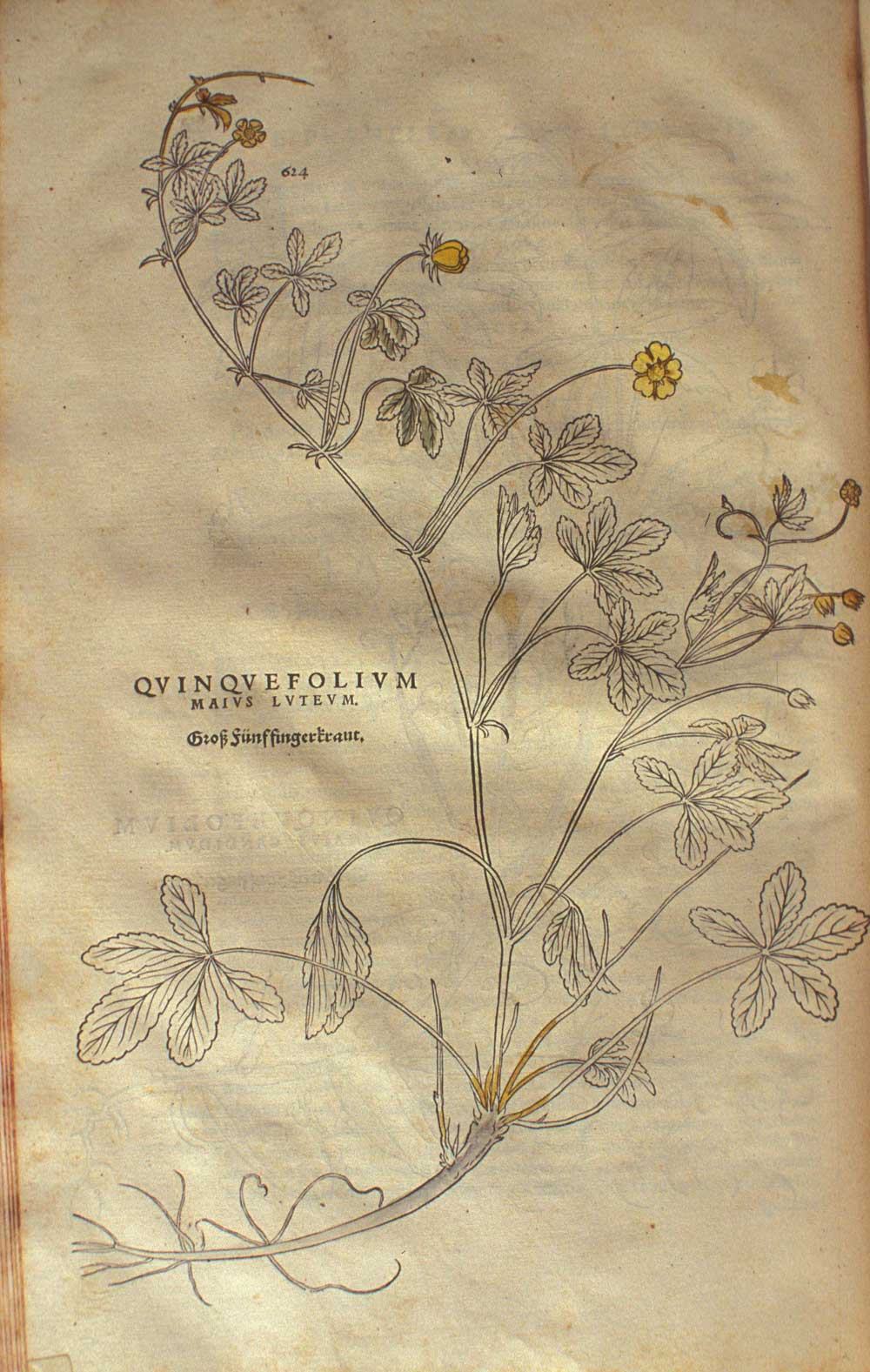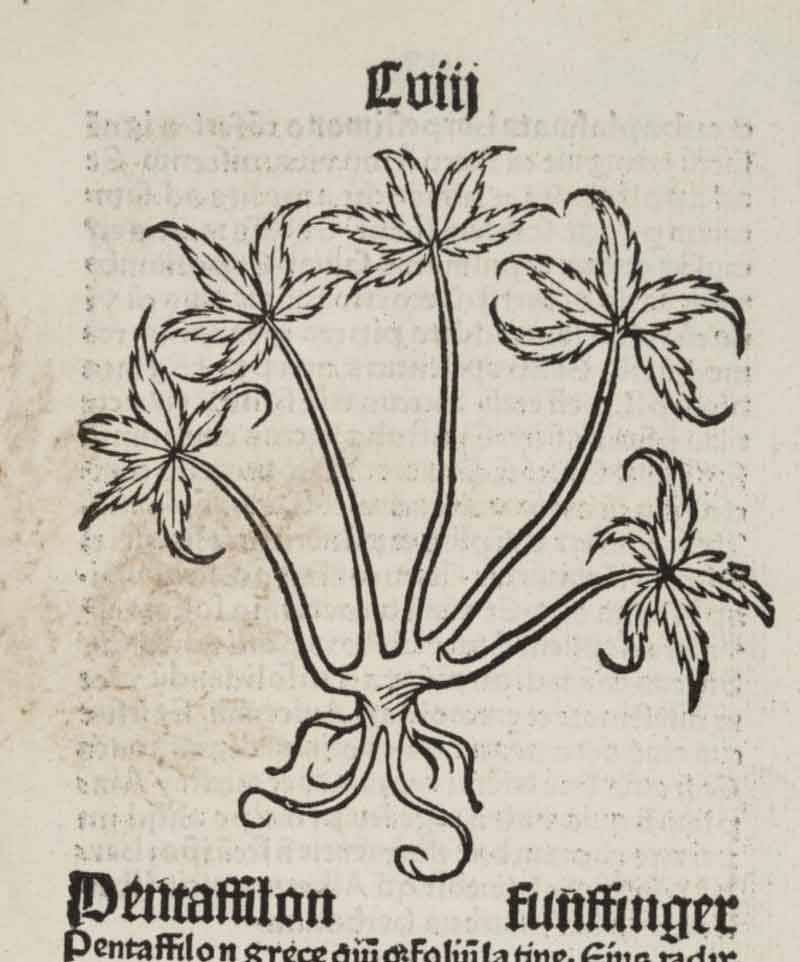pentaphyllon, which has five leaves;
Original French: Pentaphyllon, qui ha cinq feueilles:
Modern French: Pentaphyllon, qui a cinq feueilles:
Among the plants named for their forms. The plants in this group also appear in Charles Estienne’s De Latinis et Graecis nominibus…[1], published in Paris in 1544, two years before the first edition of the Le Tiers Livre[2].
1. Estienne, Charles (1504–1564), De Latinis et Graecis nominibus arborum, fruticum, herbarum, piscium & avium liber : ex Aristotele, Theophrasto, Dioscoride, Galeno, Nicandro, Athenaeo, Oppiano, Aeliano, Plinio, Hermolao Barbaro, et Joanne Ruellio : cum Gallica eorum nominum appellatione. Paris: 1544. Bibliothèque nationale de France
2. Rabelais, François (1494?–1553), Le Tiers Livre des faictz et dictz Heroïques du noble Pantagruel: composez par M. François Rabelais docteur en Medicine, & Calloïer des Isles Hieres. L’auteur susdict supplie les Lecteurs benevoles, soy reserver a rire au soixante & dixhuytiesme livre. Paris: Chrestien Wechel, 1546. Gallica
Notes
Pentassilon
Pentaphyllon

Quinquefolium
maius luteum
Gross funffingerkraut
Taxon: Potentilla reptans L.
Modern names:
English: creeping cinquefoil
French: quintefeuille
German: Fuenffingerkraut
pentaphyllon
Quinquefolium nulli ignotum est, cum etiam fraga gignendo commendetur, Graeci pentapetes aut pentaphyllon aut chamaezelon vocant. cum effoditur, rubram habet radicem. haec inarescens nigrescit et angulosa fit. nomen a numero foliorum. et ipsa herba incipit et desinit cum vite. adhibetur et purgandis domibus.
Cinquefoil is known to everyone, being popular for its actually producing strawberries. The Greeks call it pentapetes, pentaphyllon, or chamaezelon. When it is dug up it has a red root, which as it dries becomes black and angular. The name is derived from the number of the leaves. The plant itself buds and sheds its leaves with the vine. It is also used in purifying houses.
Pentaphyllon
Pliny xxv. 9, § 62.
Pentaphyllon
Pentaphyllon, quintefeuille, allusion aux feuilles digitées, à cinq foliole, del la plante. «Quinquefolium… Græci… pentaphyllon… vocant». (Pline, XXV, 62). C’est Potentilla reptans, L. (Rosacée.) (Paul Delaunay)
Les aultres de leurs formes
Encore une fois, tout cela se retrouve dans le petit livre de Charles Estienne, De latinis nominibus.
Pentaphyllon
Agrippa, De occulta philosophia, II, iii, précise que l’on voit dans les propriétes du pentaphyllon, appelé quintefeuille, les vertus du nombre quinaire.
cinquefoil
cinquefoil, cinqfoil. Forms: sinkfoil, (qwynfoile), synkfoil(e, cinkfoly, -ie, cinfoly, cinkfoile, (cinkefield), cinqfile, cinquefole, (cintfoyle), sinke-, synke-, sinckefoyle, cinke-, cinquefoile, -foyle, cinkfoil, sinkefoile, (sinkfield), cinqfoil, cinquefoil. [formed on Old French type *cinkfoil, modern French quintefeuille (quintefoil in Alphita, 15th c.), corresponding to Latin quinquefolium, formed on quinque five + folium leaf.]
The plant Potentilla reptans (N. O. Rosaceæ), with compound leaves each of five leaflets. Also used of other species with similar leaves, and as a book-name for the whole genus.
1545 Thomas Raynalde, The byrth of mankynde, otherwyse named the womans booke. 81 Take of cinkefoyle the leues and rotes.
1562 William Turner A new herball, the seconde parte (1568) ii. 110 b, Quinquefolium is named in English Cinkfoly, or fyvefyngred grasse, or herb fyvelefe.
1573 Thomas Tusser Fiue hundreth pointes of good husbandrie (1878) 97 Necessarie herbes to growe in the garden for Physick… Cinqfile.
1580 Hollyband Treas. French Tong., Quintefueille… an Hearbe called Cinkefield.
1589 Greene Menaphon (Arb.) 36 There growes the cintfoyle, and the hyacinth.
1676 Hobbes Iliad (1677) 33 Upon lote and cinquefoil feeding.
